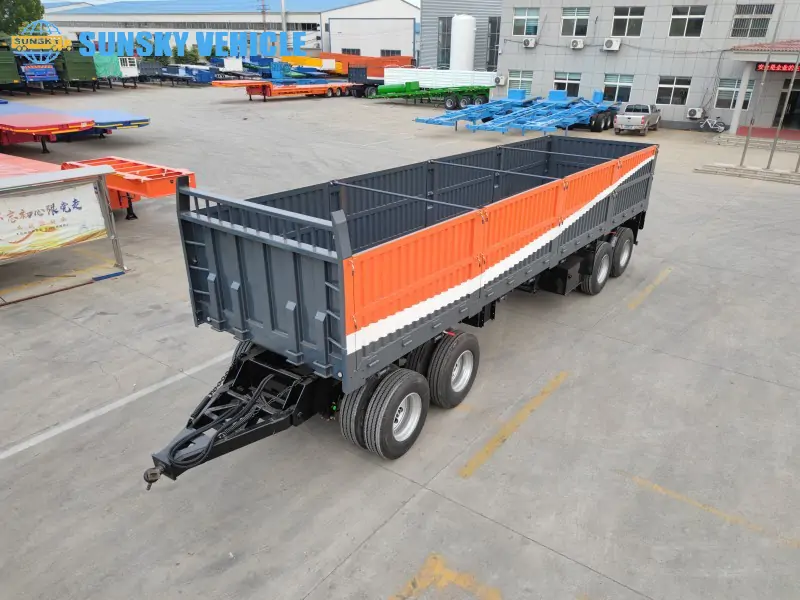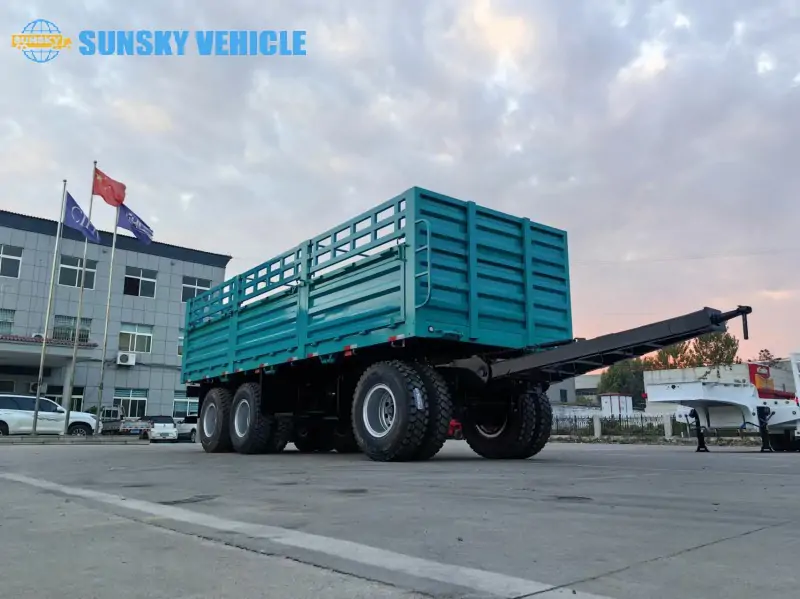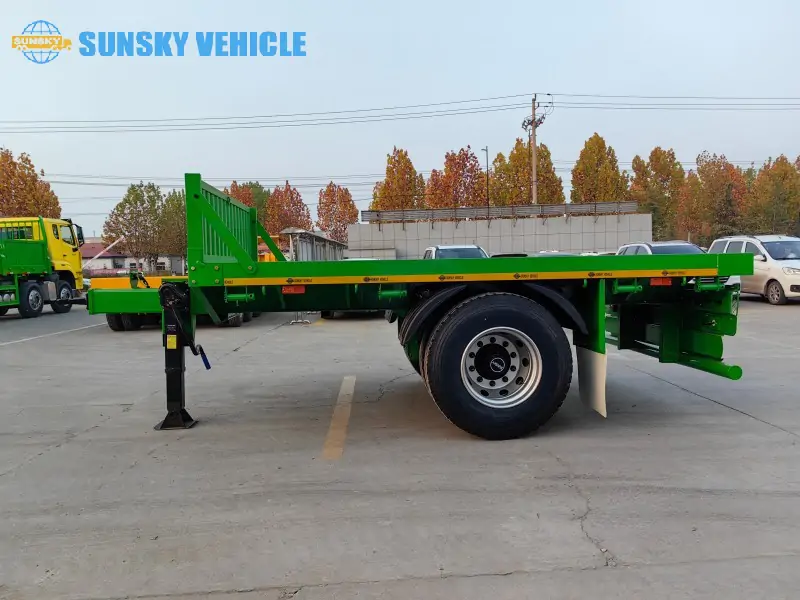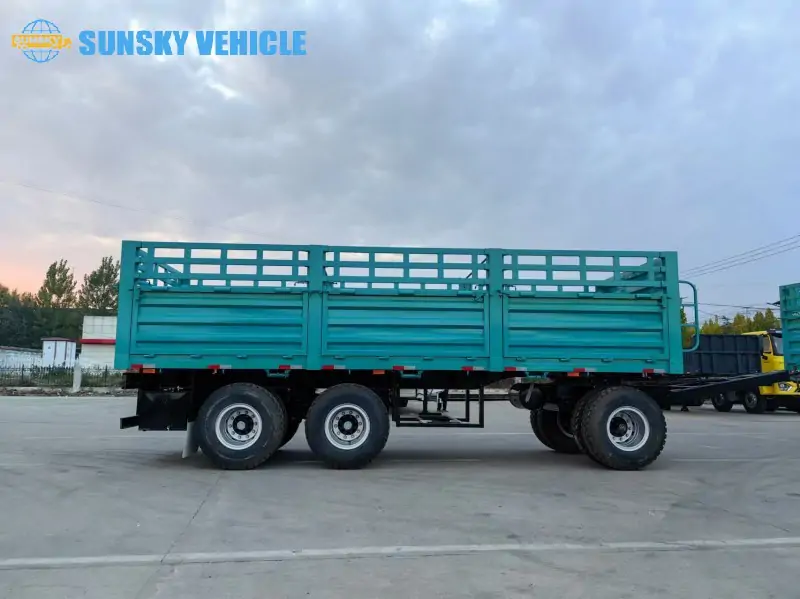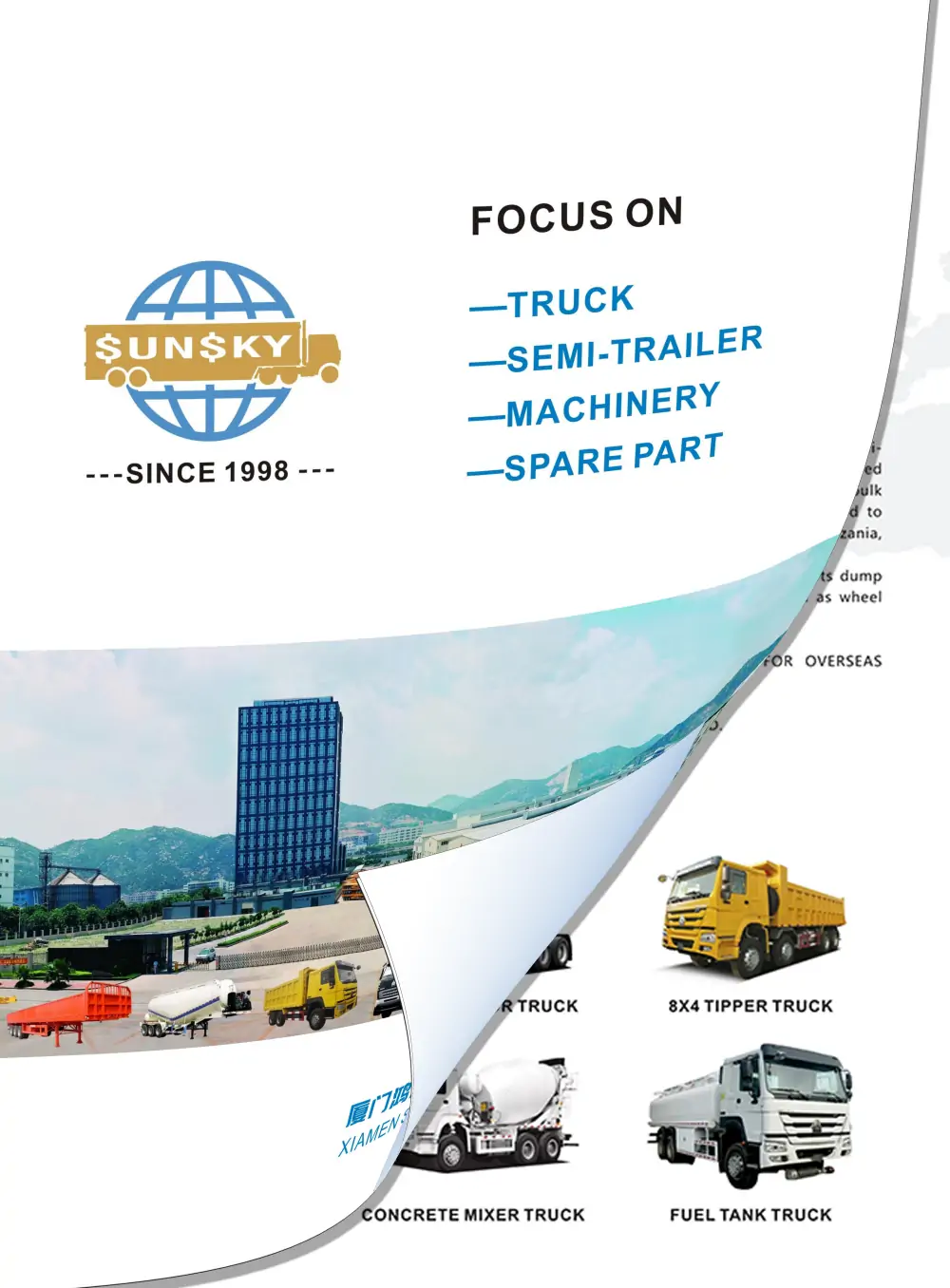When it comes to road freight transport, trailers play a critical role in moving heavy loads efficiently and safely. Among the different trailer types used worldwide, the drawbar trailer often stands out — but what exactly is a drawbar trailer, and how does it differ from a semi-trailer?
Understanding this type of trailer is essential for anyone involved in logistics, fleet management, or vehicle procurement, as choosing the right trailer design can directly impact transport efficiency, operational costs, and safety performance.
In this article, we’ll explore everything you need to know about drawbar trailers — from their definition and structure to their advantages, types, and key differences from other trailer designs. By the end, you’ll have a clear understanding of how drawbar trailers work and when they are the best choice for your transport operations.
What is a Drawbar Trailer?
A drawbar trailer, also known as a full trailer, is a type of unpowered vehicle that is designed to be towed by a truck or tractor using a drawbar connection. Unlike a semi-trailer, which transfers part of its load onto the tractor unit, a drawbar trailer is self-supporting, meaning its entire weight is carried by its own front and rear axles.
In the United States and New Zealand, drawbar trailers are commonly referred to as full trailers, while in Australia, they are often called dog trailers. Regardless of the terminology, the basic concept remains the same: the trailer has a front axle assembly connected to the towing vehicle through a drawbar, allowing it to pivot and follow the movement of the truck.
Key Difference from a Semi-Trailer
A semi-trailer connects to a tractor via a kingpin and fifth wheel coupling, transferring a significant portion of its weight to the tractor unit. In contrast, a drawbar trailer connects through a rigid or hinged drawbar, keeping its weight independent from the towing vehicle.
This design difference makes drawbar trailers particularly useful in operations where load distribution, stability, and flexibility are priorities — such as multi-drop deliveries, short-distance transport, or industrial logistics.
Main Components and Working Mechanism
A drawbar trailer consists of several essential components that define its function and versatility:
-
Drawbar (Towing Arm):
The key connecting element between the towing vehicle and the trailer. The drawbar may be fixed or hinged, and it usually includes a drawbar eye or ring coupling that attaches to the truck’s towing hook or pin coupling. -
Axles (Front and Rear):
Unlike semi-trailers, a drawbar trailer typically features two or more axles, one at the front and one at the rear. This dual-axle configuration allows the trailer to be self-supporting and ensures even load distribution across the vehicle. -
Chassis and Body Structure:
The frame or chassis supports the cargo body, which can come in various configurations — flatbed, box, sidewall, tipper, or refrigerated — depending on the intended application. -
Steering Front Axle (for certain designs):
Some drawbar trailers include a steerable front axle connected to the drawbar pivot, allowing the trailer to follow the truck’s turning path more smoothly and improving maneuverability in tight spaces. -
Coupling and Braking System:
Drawbar trailers use mechanical or air-assisted braking systems connected to the towing vehicle. The drawbar eye and coupling device must meet regional safety and load standards to ensure secure towing operations.
How It Works
When the towing vehicle accelerates or turns, the drawbar transmits tensile or compressive forces to the trailer, while the front axle pivots to follow the direction of movement. Since the trailer supports its own load, the towing vehicle’s suspension and drivetrain are less stressed, offering smoother handling when correctly balanced.
This self-supporting nature is what distinguishes drawbar trailers from semi-trailers — the load rests entirely on the trailer’s axles, not on the tractor’s fifth wheel.
Drawbar Trailer vs Semi-Trailer vs Other Trailer Types
What Is a Semi-Trailer?
A semi-trailer is a type of trailer that does not have a front axle. Instead, it relies on a fifth-wheel coupling mounted on the tractor unit to support part of its weight. The kingpin on the trailer locks into the tractor’s fifth wheel, forming a rigid connection that allows the vehicle combination to act as a single articulated unit.
Because part of the trailer’s load is carried by the tractor, semi-trailers are generally more stable at high speeds and easier to reverse. This configuration dominates long-haul freight operations worldwide due to its efficiency, higher payload capacity, and maneuverability on highways.
Key Differences Between Drawbar Trailers and Semi-Trailers
| Feature | Drawbar Trailer (Full Trailer) | Semi-Trailer |
|---|---|---|
| Axle Position | Has front and rear axles; fully supports its own weight | No front axle; part of load supported by tractor |
| Connection Type | Drawbar coupling (eye and pin or tow hitch) | Kingpin and fifth wheel coupling |
| Weight Distribution | Entire load rests on the trailer’s axles | Part of the weight is transferred to tractor |
| Stability | Very stable when loaded correctly but less suited for high-speed turns | Generally more stable at higher speeds due to load transfer |
| Maneuverability | Harder to reverse; requires skill to handle multiple pivot points | Easier to reverse; behaves as a single articulation point |
| Flexibility | Can be detached and parked independently; often used in tandem combinations | Dependent on tractor unit for support; cannot stand alone |
| Typical Use Cases | Local or regional haulage, short-distance transport, factory logistics, tandem combinations | Long-distance highway transport, container logistics, heavy freight movement |
Robust and Durable, Achieve Exceptional Transport
Start your project today and get a high-performance semi-trailer solution tailored specifically to your unique needs.
Robust and Durable, Achieve Exceptional Transport
Start your project today and get a high-performance semi-trailer solution tailored specifically to your unique needs.
Operational Suitability and Use Cases
-
Drawbar Trailers (Full Trailers):
These are most suitable for short-haul and regional operations where frequent coupling, uncoupling, or maneuvering in confined areas is required — for example, distribution centers, factory yards, or multi-drop deliveries.
They are also preferred in tandem combinations (a truck pulling two or more trailers) for maximum load flexibility. -
Semi-Trailers:
Semi-trailers dominate long-distance and heavy-haul transport due to their greater payload efficiency, stability, and easier handling at high speeds. They are ideal for intercity freight, container transport, and logistics fleets that require rapid trailer interchange. -
Other Trailer Types (e.g., Center-Axle Trailers):
Between drawbar and semi-trailers lies the center-axle trailer, which has its axle group near the center and connects to the truck via a shorter drawbar. It combines the maneuverability of semi-trailers with the stability of full trailers, and is increasingly popular for European road regulations and urban logistics.
In summary, both drawbar and semi-trailers serve distinct roles in transport logistics. The choice between them depends on operating distance, cargo type, and fleet configuration goals.
If maximum flexibility and modularity are required, a drawbar trailer setup is often the better option. For high-speed, long-distance freight, the semi-trailer remains the industry standard.
Drawbar Trailer Types and Applications
Drawbar trailers come in many designs, each tailored for specific types of cargo and operational needs. Depending on the industry and environment, the trailer structure and material can vary to ensure maximum efficiency and safety.
Below are the most common types of drawbar trailers and their typical applications:
1. Flatbed Drawbar Trailer
The flatbed drawbar trailer is one of the most versatile designs. With an open platform and no fixed sidewalls or roof, it is ideal for transporting heavy or oversized cargo such as machinery, steel pipes, building materials, or containers.
Its simplicity allows for easy loading and unloading from any direction, making it a popular choice in construction sites, logistics depots, and ports.
2. Box (Enclosed) Drawbar Trailer
The box-type drawbar trailer, also called an enclosed drawbar trailer, features a sealed cargo body that protects goods from weather, dust, and theft.
It is commonly used for transporting packaged products, electronics, furniture, and general goods that require a clean, secure environment.
Retail distribution fleets often prefer this type because it maintains cargo integrity during frequent city deliveries.
3. Sidewall (Stake) Drawbar Trailer
The sidewall or stake drawbar trailer includes removable or fixed side panels to secure loose or bulk materials such as bags of cement, pallets, agricultural produce, or construction supplies.
Its design offers a balance between protection and easy access for loading, making it ideal for regional distribution and agricultural transport.
4. Tipper (Dump) Drawbar Trailer
A tipper drawbar trailer is equipped with a hydraulic lifting system that allows the trailer bed to tilt for unloading bulk materials like sand, gravel, coal, or waste.
These trailers are highly efficient for mining, construction, and waste management operations, where fast loading and unloading cycles are essential.
5. Curtain Side Drawbar Trailer
The curtain-side drawbar trailer combines the flexibility of a flatbed with the protection of a box trailer.
The sides are covered with flexible curtains that can be easily pulled back for side loading, then secured again for weather protection.
It’s an ideal solution for freight companies that handle diverse cargo sizes and require fast loading turnaround times at warehouses or hubs.
6. Refrigerated (Reefer) Drawbar Trailer
The refrigerated drawbar trailer is equipped with a temperature control unit to maintain specific thermal conditions.
It is essential for transporting perishable goods such as food, beverages, pharmaceuticals, and chemicals that must be kept cold or frozen throughout transit.
In multi-trailer (road train) setups, drawbar reefers provide additional load capacity without needing multiple tractors.
7. Specialized and Modular Drawbar Trailers
Some industries require custom-built drawbar trailers designed for unique tasks — such as low-bed trailers for heavy equipment, fuel or liquid tank drawbar trailers, or container carriers.
These modular units can be combined in tandem, allowing a single truck to haul multiple trailers for maximum payload efficiency.
Typical Industry and Operational Applications
-
Ports and Container Yards: Efficient movement of containers and heavy cargo between dock areas and storage zones.
-
Mining and Construction Sites: Transportation of bulk materials and equipment using tipper or flatbed types.
-
Factories and Industrial Parks: Internal or short-distance movement of semi-finished goods and machinery.
-
Distribution Centers and Retail Networks: Enclosed or curtain-side drawbar trailers used for multi-stop delivery operations.
-
Agriculture and Rural Logistics: Sidewall and flatbed trailers for transporting crops, fertilizer, or farming equipment.
In essence, the drawbar trailer’s modular design and versatility make it suitable for nearly every industry that relies on efficient ground transport. By selecting the right configuration — whether flatbed, tipper, or refrigerated — operators can greatly improve their logistics flexibility and cost-effectiveness.
Advantages and Disadvantages of Drawbar Trailers
Like all transport equipment, drawbar trailers have their unique strengths and limitations. Understanding these pros and cons helps operators choose the most suitable trailer configuration for their logistics or industrial operations.
Advantages (Pros)
-
Self-Supporting Design
A major advantage of drawbar trailers is that they are self-supporting, meaning the trailer’s front and rear axles bear the entire load.
This eliminates the need for the towing vehicle to carry any portion of the weight, reducing wear and tear on the tractor unit and allowing for better load balance. -
Operational Flexibility
Drawbar trailers can be easily coupled and uncoupled from towing vehicles, enabling tandem or multi-trailer configurations.
This flexibility is particularly valuable for operators who need to maximize payload capacity or adjust fleet setups quickly based on cargo volume. -
Independent Loading and Parking
Because drawbar trailers can stand on their own, they can be loaded or unloaded independently while the truck performs other tasks.
This improves turnaround efficiency and reduces downtime at loading docks or warehouses. -
Design Versatility
The drawbar system allows manufacturers to create many types of trailers — from flatbeds and tippers to refrigerated or tanker models.
The drawbar length and coupling mechanism can also be customized, offering greater design freedom for different industries. -
Better Load Distribution
Since the trailer carries its own weight, it offers excellent balance and weight distribution, which reduces stress on both the towing vehicle and road surfaces when properly loaded.
Disadvantages (Cons)
-
More Difficult to Reverse and Maneuver
Drawbar trailers have two pivot points (one at the truck and one at the front axle), making reversing and tight maneuvering more complex than with a semi-trailer.
Skilled drivers and additional training are often required to operate them safely. -
Reduced High-Speed Stability
While stable at moderate speeds, drawbar trailers may not handle highway speeds as smoothly as semi-trailers, especially when heavily loaded or operated on uneven roads.
Their longer combination length can also limit agility on narrow routes. -
Regulatory and Road Restrictions
In some countries or regions, maximum vehicle combination length regulations limit the use of multi-trailer setups.
This means drawbar trailers might not be suitable for long-distance highway transport in areas with strict road size limits. -
Higher Maintenance and Setup Complexity
Having more axles, couplings, and moving parts means increased maintenance requirements.
The drawbar, steering system, and braking connections must be regularly inspected to ensure safe operation. -
Less Common in Certain Markets
In regions where semi-trailers dominate logistics (such as North America or parts of Europe), drawbar trailers may be less supported by repair facilities and spare parts availability.
This can lead to longer maintenance times or higher operational costs if replacement parts are not locally available.
Practical Considerations
When deciding whether to invest in drawbar trailers, operators should assess several key factors:
-
Road and Traffic Conditions: Narrow roads, steep gradients, or congested urban areas can make handling more difficult.
-
Regulatory Compliance: Ensure that trailer length, axle load, and coupling systems meet local transport laws.
-
Operational Costs: Although initial investment might be higher, drawbar trailers can improve productivity through flexible loading operations.
-
Maintenance and Service Access: Availability of qualified service technicians and spare parts plays a crucial role in long-term reliability.
In short, drawbar trailers excel in flexibility, self-support, and load efficiency, but they require skilled handling and proper operational environments to realize their full potential.
Companies that prioritize modular logistics systems and high trailer utilization rates often find them a smart long-term investment.
How to Choose the Right Drawbar Trailer
Choosing the right drawbar trailer is a critical decision that impacts your transport efficiency, safety, and long-term operational costs. Because drawbar systems come in many configurations — from flatbeds to box types — the selection process should consider both technical specifications and real-world usage factors.
1. Key Specifications to Consider Before Purchase
When evaluating drawbar trailers, focus on the following technical parameters to ensure they meet your operational requirements and local regulations:
-
Number of Axles
The number of axles determines both load capacity and road stability.
Common configurations include 2-axle and 3-axle drawbar trailers. Heavy-duty versions (e.g., mining or port use) may have up to 4 or more axles for enhanced durability. -
Payload Capacity
Confirm the Gross Vehicle Weight Rating (GVWR) and maximum payload according to your cargo type.
Overloading not only increases maintenance costs but can also violate transport regulations. -
Drawbar Length and Coupling Type
The drawbar length affects the turning radius and maneuverability.
Ensure the drawbar eye / pin coupling or ringfeder matches your towing vehicle’s hitch. A mismatched coupling can cause handling instability or safety risks. -
Steering and Suspension System
For urban or tight-space applications, opt for a self-steering front axle or hydraulic steering to improve flexibility.
Air or mechanical suspensions influence ride comfort and load distribution. -
Trailer Body Structure
Choose the body type based on the cargo category:-
Flatbed – for machinery, containers, or oversized goods
-
Side wall / Drop-side – for bulk materials
-
Box / Curtain-side – for general cargo
-
Tipper / Dump type – for construction and mining
-
Reefer – for temperature-sensitive goods
-
-
Regulatory Compliance
Always verify that trailer dimensions (length, width, height) and axle loads meet national transport laws.
Certain countries or regions have strict limits for drawbar combinations, especially on highways.
Robust and Durable, Achieve Exceptional Transport
Start your project today and get a high-performance semi-trailer solution tailored specifically to your unique needs.
Robust and Durable, Achieve Exceptional Transport
Start your project today and get a high-performance semi-trailer solution tailored specifically to your unique needs.
2. Matching the Right Towing Vehicle
The performance of a drawbar trailer depends heavily on the towing vehicle configuration:
-
Compatible Truck Types
Usually, rigid trucks (cargo trucks) are used as the towing unit for drawbar trailers, unlike semi-trailers that require tractor heads.
Ensure your truck’s brake system, towing capacity, and frame design can safely support the trailer. -
Coupling System Compatibility
Confirm that the truck’s coupling device is mechanically and dimensionally compatible with the drawbar’s eye or pin system.
European markets often use Rockinger or Ringfeder systems, while Asian and African regions may adopt regional standards. -
Driver Skills and Licensing
Operating a drawbar trailer requires additional driver training, especially for reversing, cornering, and multi-trailer handling.
In many regions, a higher-grade license (e.g., CE or EC) is legally required for drawbar combinations.
3. Market-Based Considerations
When selecting a drawbar trailer for your business, look beyond the technical data — evaluate how it fits into your local market conditions and operational environment:
-
Road and Infrastructure Conditions
In countries with rough or unpaved roads, prioritize trailers with reinforced frames, higher ground clearance, and robust suspension.
In contrast, urban logistics might favor lighter, shorter configurations for easier maneuverability. -
Parts and After-Sales Support
Choose a manufacturer or dealer with a strong service network and easily available spare parts.
This ensures lower downtime and simplifies maintenance scheduling. -
Brand and Manufacturer Reputation
Consider established brands that specialize in drawbar trailer production and offer custom design options.
Reputable manufacturers provide tested coupling systems and certified components, ensuring long-term safety. -
New vs. Used Equipment
Buying a used drawbar trailer can be cost-effective for small operators, but inspect the coupling wear, brake lines, and axle alignment carefully.
New trailers, while more expensive, often deliver better reliability and compliance with updated standards. -
Operational Cost and Efficiency
Beyond purchase price, assess total cost of ownership — including fuel consumption, maintenance intervals, and driver training.
A well-chosen drawbar trailer may lower per-ton transport costs and boost fleet productivity in the long run.
Selecting the right drawbar trailer requires a balanced evaluation of technical specs, operational needs, and local conditions.
Whether you operate in construction, logistics, mining, or short-haul distribution, a properly matched drawbar setup enhances safety, efficiency, and profitability.
Future Trends and Market Opportunities
The global logistics industry is entering a new phase of transformation — driven by rapid infrastructure development, sustainability goals, and digitalized fleet management. Within this evolution, the drawbar trailer market is showing renewed relevance and potential across multiple sectors.
1. Growing Market Demand and Regional Development
As global trade continues to expand, road freight remains the backbone of inland transport.
In many developing and industrializing regions, improvements in highway networks, logistics hubs, and port facilities are creating favorable conditions for drawbar trailer adoption.
-
Urban and Regional Distribution Growth
With the rise of e-commerce and last-mile logistics, fleets are increasingly seeking flexible and short-haul transport solutions.
Drawbar trailers are especially useful for multi-drop deliveries, factory-to-warehouse transport, and distribution center operations, where maneuverability and quick coupling are key advantages. -
Industrial and Construction Sector Expansion
As infrastructure projects grow, the demand for construction materials, machinery, and bulk cargo transport rises — all areas where drawbar trailers excel due to their self-supporting structure and heavy-load capability.
2. Lightweight and Sustainable Design Trends
Environmental regulations and fuel efficiency goals are reshaping how trailers are designed and built.
-
Lightweight Materials
Manufacturers are adopting high-strength steel, aluminum alloys, and composite materials to reduce trailer weight while maintaining durability.
Lighter drawbar trailers help lower fuel consumption and CO₂ emissions, directly supporting fleet sustainability targets. -
Aerodynamic Optimization
New drawbar trailer designs focus on improved aerodynamics, reducing drag and energy loss during highway transport.
Side skirting, rounded edges, and airflow management technologies are gradually becoming standard. -
Energy Efficiency and Electrification
In some markets, research into electric-powered drawbar systems or energy recovery braking is underway, particularly for city logistics.
While still in early stages, these innovations may redefine how drawbar trailers operate within zero-emission transport fleets.
3. Technological Advancements and Smart Fleet Integration
Digital transformation is another key trend influencing trailer design and fleet operations:
-
Telematics and Tracking Systems
Modern drawbar trailers can be equipped with GPS tracking, load sensors, and brake monitoring systems, enabling real-time visibility and preventive maintenance. -
Smart Coupling and Safety Features
Automatic coupling systems, electronic braking (EBS), and tire pressure monitoring are being integrated to enhance operational safety and reduce driver workload. -
Fleet Optimization and Data Analytics
Logistics companies increasingly rely on data-driven insights to optimize routes, reduce downtime, and improve fuel efficiency — creating demand for connected drawbar trailers that feed data into centralized fleet platforms.
4. Market Opportunities in Expanding Logistics Networks
The global logistics landscape continues to evolve with cross-border transport corridors, port expansions, and intermodal freight systems.
Drawbar trailers, with their modular design and flexibility, are well-positioned to benefit from these developments:
-
Port and Terminal Operations – Efficient for container shuttling, stacking, and short-haul movements within logistics hubs.
-
Cross-Border and Regional Freight – Ideal for multi-point distribution, where trailers can be decoupled and swapped quickly between regions.
-
Intermodal Transport Systems – Growing adoption of rail-to-road and port-to-warehouse networks creates new opportunities for drawbar combinations that integrate seamlessly with varied transport modes.
The future of the drawbar trailer industry lies at the intersection of efficiency, innovation, and sustainability.
With ongoing investment in logistics infrastructure and the shift toward smarter, greener transport, drawbar trailers are expected to play a growing role in modern supply chains.
For fleet operators and procurement managers, understanding these trends today ensures a stronger competitive position in tomorrow’s transport landscape.
FAQ
1. What is the difference between a drawbar trailer and a semi-trailer?
A drawbar trailer (also known as a full trailer) has both front and rear axles and supports its own weight independently. It connects to the towing vehicle via a drawbar and pin coupling, without transferring load onto the truck.
A semi-trailer, by contrast, has no front axle — part of its weight is supported by the tractor unit via a fifth-wheel coupling.
In short, a drawbar trailer is self-supporting, while a semi-trailer relies on the towing truck for partial support.
2. Can any truck pull a drawbar trailer?
Not every truck is designed to tow a drawbar trailer.
A suitable rigid truck with a compatible coupling system (such as a Ringfeder or Rockinger type) is required.
The truck must also have adequate towing capacity, braking system, and proper rear chassis design to handle the trailer safely.
Always confirm the technical specifications and legal towing limits before coupling.
3. Is a drawbar trailer suitable for long-haul highway transport?
In general, drawbar trailers are best suited for regional or short-haul logistics, such as factory-to-warehouse or city distribution.
For long-distance or high-speed highway transport, semi-trailers often provide better stability, fuel efficiency, and regulatory compliance — especially in countries with stricter road restrictions for multi-axle combinations.
4. What are the key safety or regulatory considerations for drawbar trailers?
Safety and compliance are crucial when operating drawbar combinations.
Operators should pay attention to:
-
Coupling system integrity – ensure drawbar eyes, pins, and safety chains are properly maintained.
-
Braking system synchronization between truck and trailer.
-
Lighting, reflectors, and side guards as per road transport regulations.
-
Axle load limits and total combination length, which vary by country or region.
Before operating, verify your setup complies with local transport authority rules to avoid penalties or unsafe conditions.
5. How long is the drawbar, and why does it matter?
The drawbar length typically ranges from 1.5 to 3.5 meters, depending on trailer design and legal limits.
A longer drawbar provides better turning radius and maneuverability, especially for multi-trailer combinations, but may reduce stability at higher speeds.
Shorter drawbars offer tighter coupling and better tracking on highways.
Choosing the right length depends on your operational environment and vehicle type.
Conclusion
The drawbar trailer is a versatile, self-supporting transport solution that combines high payload capacity with flexible configuration options.
Whether used for industrial logistics, construction material transport, or regional distribution, its independent axle structure and adaptable design make it a valuable asset for modern fleets.
Compared with semi-trailers, drawbar trailers excel in multi-drop routes, short-haul operations, and modular logistics systems.
However, choosing the right model — with the right coupling system, axle setup, and body type — is essential to achieve optimal performance and compliance.
If you’re looking to upgrade your fleet or explore cost-efficient drawbar trailer solutions, we can help.
Contact us today to get a customized quotation.
Your next efficient transport solution starts here.
h

